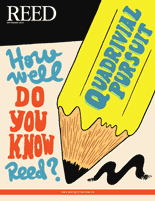
IRIS login | Reed College home Volume 93, No. 3: September 2014
Kingdom for a Hearse
Nisma Elias’ article “Looking Back at Freedom Summer” in June describes the small cadre of idealistic Reed students who went to the Deep South to register black voters during the Freedom Summer of 1964, including Ray Raphael ’65. There is one small and enjoyable error in Nisma’s story, when she quotes Ray as saying, “I drove around in a very noticeable black Pontiac Hurst...”
Ray, in fact, did not drive a “hurst,” but rather, a hearse. Talk about noticeable! It was a huge, heavy, and supremely improbable thing, quite well known on the Reed campus. His car just exuded contempt for middle-class propriety: instead of the dignified carriage of the deceased, Ray transported, in high style, many very-much-alive Reedies on their way to one political confrontation or another.
I know that Ray went on to become a successful writer about American politics and history, but I also wonder what became of his famous hearse, one of the most notable symbols of Reed’s endearing weirdness during the ’60s.
In response to Gray’s inquiry about the fate of my ’54 Pontiac hearse, here is its saga.
I purchased it for only $300, quite a steal for a car with only 3,000 miles on it—not just little-old-ladies-going-to-church miles, but dead-ladies-and-gents-inching-slowly-from-church-to-cemetery miles. Perhaps the most notable adventure during its tenure at Reed was being turned back at the Canadian border by guards who just didn’t like the feel of black and white teenagers entering their country, sprawled in the back of a hearse. I told them we were sponsored by the U.S. government, which was true—we were on a field trip from Reed’s pioneering Upward Bound program—but that made no difference. They would have none of our strange crew in Canada.
In 1968 my hearse carried me to San Francisco for my first teaching job. The hearse did not appreciate the steep hills, and it could find no rest unless we found adjacent parking spaces. The following spring we ventured to the woods of California’s “Lost Coast,” 200 miles to the north. Those dirt roads were no more to the hearse’s liking than were the streets of San Francisco, so we made a deal: I would park her in a nice, comfortable spot—put her to pasture, as it were—and she would be “home” to myself and my partner at the time, Sandy Clark Goodrick ’66. The spacious rear compartment, lined with blue velvet and accustomed to prone bodies in deep sleep, made a luxurious bedroom, and the front seat served as a kitchen of sorts.
So there she sat, at rest. Over the next few years she offered herself as home to various young folks in need of cover. She befriended a neighbor, the volunteer fire department’s truck that moved in across her dirt driveway. A few tenants later, vacant, she grew a garden of berry bushes around her. Only later, a decade or so, did she give up the ghost, hauled away to a junkyard.
What I like about her story is how she meshes with the history of the times, from political activist in the ’60s to back-to-the-land hippie in the ’70s. She was very tuned in, as we said in the day.

LATEST COMMENTS
steve-jobs-1976 I knew Steve Jobs when he was on the second floor of Quincy. (Fall...
Utnapishtim - 2 weeks ago
Prof. Mason Drukman [political science 1964–70] This is gold, pure gold. God bless, Prof. Drukman.
puredog - 1 month ago
virginia-davis-1965 Such a good friend & compatriot in the day of Satyricon...
czarchasm - 4 months ago
John Peara Baba 1990 John died of a broken heart from losing his mom and then his...
kodachrome - 7 months ago
Carol Sawyer 1962 Who wrote this obit? I'm writing something about Carol Sawyer...
MsLaurie Pepper - 8 months ago
William W. Wissman MAT 1969 ...and THREE sisters. Sabra, the oldest, Mary, the middle, and...
riclf - 10 months ago